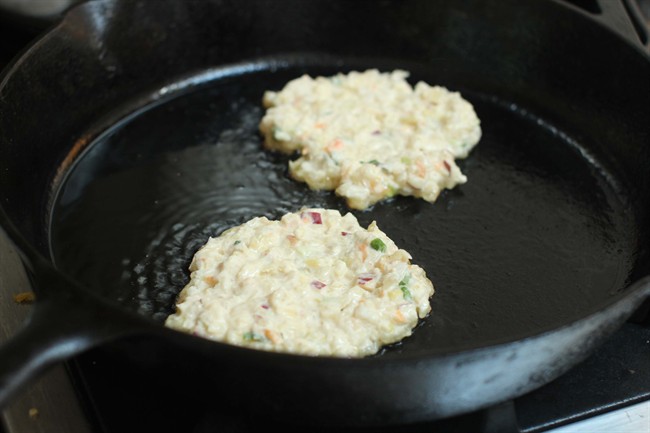I like to imagine my jar of kimchee wrapped up in a superhero cape. Packed full of fiber, stomach-healthy probiotics and — according to traditional Korean wisdom — anti-aging properties (Take that, wrinkles!), it’s no wonder this pungent chili-laced jar of fermented vegetables always has a seat at the Korean dinner table.

Think of it as Korean sauerkraut.
READ MORE: Korean foods making inroads in North America via pantry staples
My Korean-American roommates first introduced me to kimchee when I was in my 20s. Not only did they serve it alongside succulent Korean barbecued meats, but also in stir-fry, stews and even with steamed rice and roasted seaweed. At first, the bold aroma caused my eyes to sting and my nostrils to pinch shut. But I quickly fell in love, relishing the way the sour spice brought even a mundane burger to life.
There are hundreds of varieties of kimchee, from the most popular Napa cabbage version, to cucumber, green onion, radish and pear. My friend, Debbie Lee, author of “Seoultown Kitchen,” encouraged me to make my own kimchee, since commercial varieties can contain MSG and sugar.
My favourite way to use kimchee is the traditional Korean snack, panjeon, a sort of pancake. Lee uses sparkling water to keep the pancake light. I add a little apple to tame the kimchee’s heat. Look for kimchee in the refrigerated section of better supermarkets. I like Napa cabbage kimchee made with no MSG. If you’re not into heat, look for “white kimchee,” which contains no gochugaru (Korean red chili powder).

Get daily National news
___
KOREAN KIMCHEE PANCAKE WITH APPLE
This recipe fits perfectly into a 12-inch nonstick skillet. Also, make sure the water is very cold; I sometimes add a couple ice cubes to the water while I’m prepping the rest of the ingredients. Ice cold water makes for crispy pancakes.
Start to finish: 20 minutes
Servings: 4 starters or 2 mains
- 1 cup finely chopped Napa cabbage kimchee, drained
- 3 tablespoons kimchee juice (from the jar)
- 2 tablespoons minced yellow onion
- 3 tablespoons minced Fuji apple (peel on)
- 1 scallion, finely chopped (greens and whites)
- 1/2 teaspoon sugar
- 1/4 teaspoon kosher salt
- 1/2 cup all-purpose flour
- 1/4 cup chilled sparkling water
- 3 to 4 tablespoons sunflower or grapeseed oil
For the dipping sauce:
- 1/4 cup soy sauce
- 1 teaspoon sesame oil
- 1 teaspoon rice vinegar
- Big pinch toasted sesame seeds
In a medium bowl and using a fork, stir together the chopped kimchee, kimchee juice, onion, apple, scallion, sugar and salt. Sprinkle in the flour and stir together again until the flour is evenly incorporated. Add the water, a little at a time, until a very slight batter forms. It should look very thick, mostly kimchee with hardly any batter pooling around it.
Set a large cast-iron skillet over high heat and let become very hot. Add the sunflower oil, turning the pan to spread it evening. Working in batches, add 1/2 cup of the batter and use the back of a spoon to spread the batter flat to form a 4-inch pancake. Cook for 3 to 4 minutes, or until golden brown and crispy on the bottom and the top is set up.
Use a spatula to flip the pancake and cook for another 3 to 4 minutes, or until crispy on the bottom. Flip one more time and cook for another minute. You’re aiming to get brown and even black bits on the surface of the pancake. Transfer the pancake to a wire rack lined with paper towels and let cool slightly before cutting into wedges. Repeated with remaining batter.
Meanwhile, make the dipping sauce. In a small bowl, stir together the soy sauce, sesame oil, rice vinegar and sesame seeds. Serve the pancake wedges with the dipping sauce.
Nutrition information per serving (based on 4 servings): 200 calories; 120 calories from fat (60 per cent of total calories); 13 g fat (1.5 g saturated; 0 g trans fats); 0 mg cholesterol; 1100 mg sodium; 17 g carbohydrate; 2 g fiber; 2 g sugar; 4 g protein.





Comments